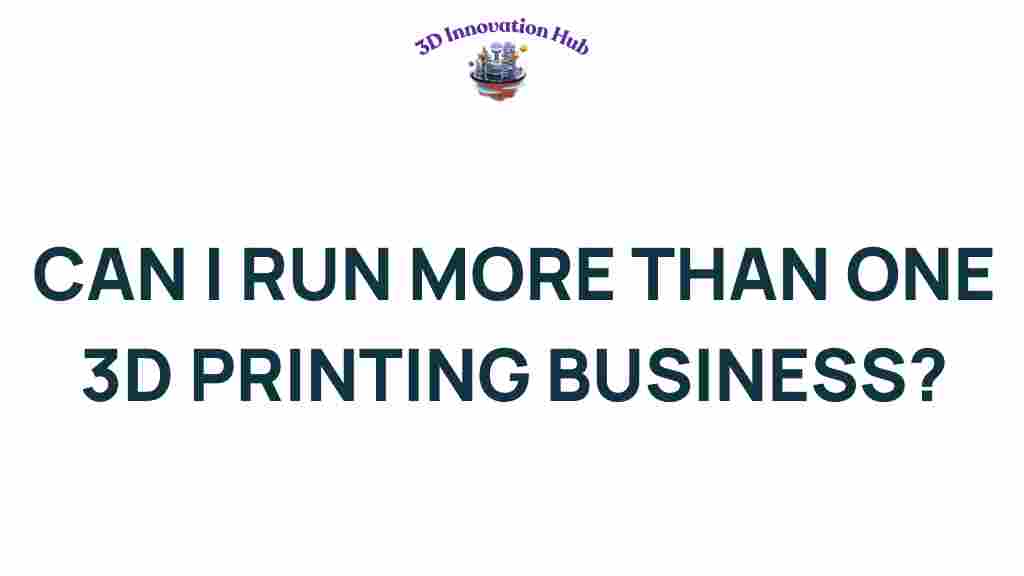Exploring the Viability of Multiple 3D Printing Ventures
In recent years, the world of 3D printing has become a hotbed for entrepreneurship and innovation. With advancements in technology and a growing interest in personalized products, many individuals and startups are looking to capitalize on this burgeoning field. This article will explore the viability of multiple 3D printing ventures, focusing on business strategy, market trends, and the potential for profitability in the small business sector.
Understanding 3D Printing Technology
3D printing, also known as additive manufacturing, refers to the process of creating three-dimensional objects from digital files. This technology has evolved dramatically over the past few decades, and it now encompasses a wide range of materials, including plastics, metals, and even biological materials. Entrepreneurs entering this space need to understand the fundamentals of 3D printing to successfully navigate the market.
Current Market Trends in 3D Printing
The 3D printing industry is experiencing significant growth, driven by several key trends:
- Customization: Consumers are increasingly seeking personalized products, and 3D printing allows for mass customization at a lower cost.
- Sustainability: Eco-conscious consumers are drawn to 3D printed products that reduce waste and use sustainable materials.
- Industry Expansion: Sectors such as healthcare, automotive, and aerospace are adopting 3D printing for prototyping and production.
- Innovation: New materials and techniques are constantly emerging, providing entrepreneurs with fresh opportunities.
Developing a Business Strategy for 3D Printing Startups
When considering a 3D printing venture, a well-thought-out business strategy is essential. Here are the steps to develop a successful plan:
1. Market Research
Before launching your startup, conduct thorough market research to identify potential niches. Look for gaps in the market where 3D printing can solve a problem or meet a demand. Consider factors such as:
- Target demographics
- Competitor analysis
- Current market trends and technologies
2. Define Your Niche
Once you have gathered sufficient data, define your niche. This could be anything from custom jewelry to industrial parts. Your niche will determine your business strategy and marketing efforts.
3. Create a Business Plan
Your business plan should outline:
- Your mission and vision
- Market analysis
- Marketing strategy
- Operational plan
- Financial projections
A well-structured business plan will also help attract investors and secure funding for your 3D printing venture.
4. Choose the Right Technology
Selecting the right 3D printing technology is crucial. Consider factors such as:
- Material compatibility
- Production speed
- Cost of equipment
Popular 3D printing technologies include Fused Deposition Modeling (FDM), Stereolithography (SLA), and Selective Laser Sintering (SLS).
5. Develop Your Brand
Creating a strong brand identity is vital for attracting customers. Focus on:
- Logo and design
- Brand messaging
- Online presence, including a website and social media
A recognizable brand will help you stand out in a competitive market.
6. Launch and Market Your Product
Once your product is ready, it’s time to launch. Use various marketing strategies to reach your target audience, such as:
- Social media advertising
- Influencer partnerships
- Content marketing
- Email campaigns
Monitor the performance of your marketing efforts and adjust your strategy as needed.
7. Evaluate and Pivot
As with any startup, it is essential to continually evaluate your business’s performance. Use key performance indicators (KPIs) to measure success and be prepared to pivot your strategy if necessary. This could involve:
- Introducing new products
- Exploring new markets
- Adjusting pricing strategies
Troubleshooting Common Challenges in 3D Printing Ventures
Starting a 3D printing business comes with its share of challenges. Here are some common issues and how to troubleshoot them:
1. Technical Difficulties
Hardware and software malfunctions can disrupt production. To troubleshoot:
- Regularly maintain and calibrate your printers.
- Keep software updated to avoid compatibility issues.
- Invest in training for yourself and your staff.
2. Supply Chain Issues
Delays in material supply can hinder your ability to deliver products. Mitigate this risk by:
- Establishing relationships with multiple suppliers.
- Keeping an adequate inventory of essential materials.
3. Market Competition
The 3D printing market is competitive. Stay ahead by:
- Continuously innovating your product offerings.
- Conducting regular market analysis to understand competitors.
4. Customer Satisfaction
Customer complaints can impact your brand’s reputation. Enhance customer satisfaction by:
- Providing excellent customer service.
- Actively seeking and responding to customer feedback.
Conclusion
The landscape of 3D printing offers exciting opportunities for entrepreneurship and innovation. By understanding market trends, developing a robust business strategy, and proactively addressing challenges, aspiring entrepreneurs can create successful startups in this dynamic field. As technology continues to evolve, those who adapt and innovate will find themselves at the forefront of the 3D printing revolution.
For more insights on starting a small business, consider exploring resources at Small Business Administration and stay updated with the latest trends in 3D printing technology at 3D Printing Industry.
This article is in the category and created by 3D Innovation Hub Team
